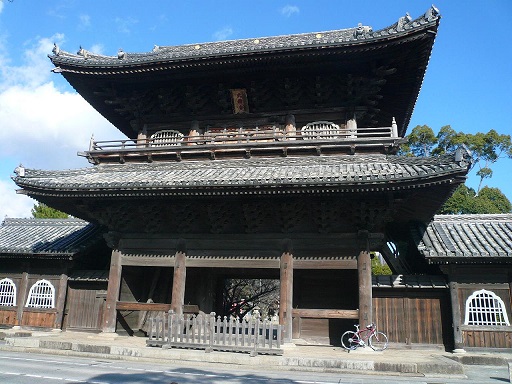The temple was surrounded by ODA's army and Ieyasu lost all hope for the future.
The chief priest of the Daijyuji temple admonished Ieyasu with the words of "Enri-Edo" and "Gongu-Jyodo".
The meaning of these words is abhorring this impure world and seeking rebirth in the Pure Land.
In the 16th century, Japan was in the age of Civil Wars. Japan was divided into around 200 territories. Each lord tried to expand their territory by battles.
Ieyasu was encouraged with these words and decided to realize these words as to unify these territories.
These words are displayed on both sides of a Buddha statue inside the main hall.
TOKUGAWA Iemitsu, a grandson of Ieyasu, improved the temple buildings from 1636. The location of the main hall and the main gates were aligned with Okazaki Castle. You will see the tower building of Okazaki Castle through the main gates of Daijyuji Temple.
The alignment is called "VISTA Line". The city of Okazaki protects the view of Okazaki Castle from Daijyuji Temple by controlling construction of buildings between Okazaki Castle and Daijyuji Temple.
To the west of the main hall, a two-storied pagoda is located.
The pagoda was built in 1535 by MATSUDAIRA Kiyoyasu, the grandfather of Ieyasu".
The pagoda is designated as an important property of Japan.
At the north end of Daijyuji Temple, tombs of eight generations of MATSUDAIRA family are located.
These tombs are from MATSUDAIRA Chikauji, the first generation, to MATSUDAIRA Hirotada, eighth generation and father of Ieyasu.
The tomb of TOKUGAWA Ieyasu is also located here.
In Daijyuji Temple, mortuary tablets of fourteen TOKUGAWA Shoguns are preserved at Treasure Hall.
This is according to the will of TOKUGAWA Ieyasu.

 Home Page in Japanese: "Shane's HomePage"
Home Page in Japanese: "Shane's HomePage"

 Home Page in Japanese: "Shane's HomePage"
Home Page in Japanese: "Shane's HomePage"